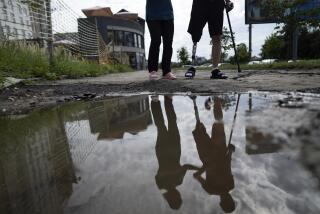Sculpture Re-Creates Ears, Noses : Disfigured Patients Given a New Image
- Share via
ANN ARBOR, Mich. — Silicone, plaster and glue can go a long way toward helping to heal wounded self-images.
“I think it’s amazing,” says Denis Lee, head of the University of Michigan Medical Center’s Medical Sculpture Unit. “A lot of people, when they first come, are hesitant about wearing anything artificial or rubber. They think it will fall off, or people will laugh.
“After they see the results, it’s incredible.”
Hundreds of people each year who have lost an eye, ear, nose, finger, toe, breast or other feature to birth defects, cancer, accidents and fire--and who can’t be helped by plastic surgery--seek assistance from prosthetic artists.
“I really don’t know what to say for making me feel like a whole person again,” a 69-year-old Ohio woman, whose face was disfigured and right eye lost to cancer, wrote to Lee.
‘People Don’t Stare’
“People just can’t believe how anyone can do such a wonderful job. I can go any place and people don’t stare. It’s a wonderful feeling to have in my life again.”
Stan Stasilowicz, 63, of Union Lake, lost his right ear to cancer two decades ago. “I said to some of my cronies that I got a new ear, and they said which one? It was very exhilarating.”
Prosthetics can be especially important for children, says Lee, who is seeking a corporate sponsor for a center for disfigured children here. “If not treated properly and quickly, they can have psychological problems. Children can be pretty cruel and (disfigured) children get teased.”
TV Bionic Programs Help
Popular shows and movies have helped alleviate that problem. In the “Six Million Dollar Man,” and “Bionic Woman” series, people with mechanical parts have superhuman strength, and the recent movie “Robo Cop” dealt with replacing lost features and organs with mechanical ones.
“If they’re the bionic kid,” Lee says, “they’re the hit of the class.”
Of about 200 patients treated here annually Lee estimates the breakdown is 50 ears, 30 breasts, 20 noses, 20 eyes and 50 “miscellaneous.” Most health insurance covers the cost, which runs about $1,400 for an ear or nose and $2,000 for an eye.
There are about 200 prosthetic sculptors working in the United States, most of them affiliated with Michigan, a Veterans Administration clinic in New York City and a medical center associated with Baylor University, according to Lee, who also directs a 22-year-old graduate program to train the artists.
The University of Illinois, Ohio State University, Johns Hopkins University, the Medical College of Georgia and the University of Texas also offer such courses. “It’s harder to get into than medical school. It’s a very strange combination to have people interested in science and art--that’s why the program is so small,” Lee says.
The course of study includes anatomy, pathology, anatomical sketching, medical and scientific drawing, and medical graphics. Graduates generally can set up their own business, free lance, or work for a hospital or medical center.
One works for “Star Wars” creator George Lucas’ Industrial Light and Magic making creatures for science fiction films.
Undamaged Feature Matched
Sculptors take a plaster mold of the patient’s undamaged feature, then make a silicone rubber copy and carefully match skin tone. The replacement is applied daily with a medical adhesive.
More to Read
Sign up for Essential California
The most important California stories and recommendations in your inbox every morning.
You may occasionally receive promotional content from the Los Angeles Times.










